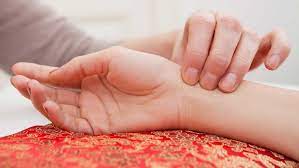Diseases

Pulse Diagnosis
Pulse diagnosis, known as "Nadi Pariksha" in Ayurveda, is a fundamental and highly specialized diagnostic technique used in Ayurvedic medicine. It involves the assessment of a person's overall health, constitution, and imbalances by examining the pulse at the radial artery. Ayurvedic practitioners believe that the pulse carries information about the body's dosha (constitutional type), the balance of doshas, and the state of various organs and systems.
Here's an overview of pulse diagnosis in Ayurveda:
1. **Three Doshas:** Ayurveda identifies three primary doshas or biological energies - Vata, Pitta, and Kapha. Each dosha has specific qualities and functions in the body. Pulse diagnosis helps determine the predominance of these doshas and their balance within an individual.
2. **Pulse Points:** Ayurvedic pulse diagnosis focuses on specific pulse points on the radial artery, which are associated with different doshas and organs. These points are examined individually to assess their characteristics and qualities.
3. **Characteristics of the Pulse:** Ayurvedic practitioners analyze various aspects of the pulse, including its rhythm, speed, depth, strength, and qualities such as hot, cold, rough, or smooth. Each of these characteristics provides insights into the individual's constitution and any existing imbalances.
4. **Dosha Imbalances:** An Ayurvedic practitioner can identify dosha imbalances by feeling the pulse. For example, if the pulse is rapid, irregular, and feeble, it may indicate a Vata imbalance. If it is strong, bounding, and rapid, it could suggest a Pitta imbalance, and if it is slow and heavy, it may indicate a Kapha imbalance.
5. **Organ and System Assessment:** Pulse diagnosis in Ayurveda goes beyond dosha assessment. Practitioners are trained to detect specific organ and system imbalances or diseases by feeling the pulse points associated with those areas.
6. **Constitutional Analysis:** Through pulse diagnosis, Ayurvedic practitioners determine an individual's Prakriti (constitution) and Vikriti (current imbalances). This information helps tailor Ayurvedic treatments, including dietary recommendations, herbal remedies, and lifestyle adjustments, to restore balance and promote overall health.
7. **Tracking Progress:** Pulse diagnosis is not only used for initial assessments but also to monitor the progress of treatment. As the individual's doshas and overall health improve, changes in the pulse characteristics can be observed.
8. **Individualized Treatment:** One of the key principles of Ayurveda is personalized medicine. Pulse diagnosis allows practitioners to customize treatments to address the unique needs of each patient, promoting holistic healing.
